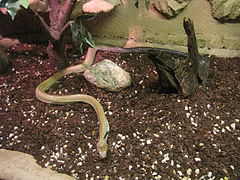- Middle American Indigo Snake
-
Middle American Indigo Snake Drymarchon melanurus Conservation status Scientific classification Kingdom: Animalia Phylum: Chordata Class: Reptilia Order: Squamata Family: Colubridae Subfamily: Colubrinae Genus: Drymarchon Species: D. melanurus Binomial name Drymarchon melanurus
Duméril, Bibron & Duméril, 1854Subspecies D. m. erebennus (Cope, 1860)
Synonyms Spilotes melanurus
Spilotes corais melanurus
Drymarchon corais melanurus
Drymarchon corais melanurusThe Middle American indigo snake (Drymarchon melanurus), also known as Blacktail Cribo, is a large, non-venomous, colubrid snake species found in the south-west of the United States, Mexico, Central America, and the northern part South America. It has one recognized subspecies, D. m. erebennus commonly known as the Texas Indigo Snake.[2]
Contents
Description
This is a large species that can grow to lengths from 1.80 m (6 ft) to over 2.40 m (8 ft). This species has predominantly olive-brown glossy scales evolving to black at the tail. The underside is a lighter olive-yellow, olive-tan color. D. melanurus has distinctive dark markings round the eyes, a vertical dark slash just behind the jaw. and a heavy diagonal dark slash on both sides of the neck.[3] The subspecies D. m. erebennus is predominantly solid black, though there can be lighter shaded variations.
Range and habitat
Its range extends from southern Texas southwards through the Gulf Coast of Mexico, the Yucatan peninsula, Guatemala and Belize. On the Pacific coast its range extends from Sinaloa in Mexico, southward to Guatemala, as far as Colombia, Venezuela and Ecuador.[3] [1] Its elevational distribution goes from near sea level up to around 1,900 m asl (6,230 feet).[1] The subspecies D. m. erebennus is found in southern Texas and southwards into Mexico as far as Veracruz.
Subspecies
There are two recognized subspecies, including the nominal subspecies:[2]
- D. m. erebennus (Cope, 1860)
- D. m. melanurus (Dumeril, Bibron & Dumeril, 1854)
References
- ^ a b c "Drymarchon melanurus". IUCN Red List of Threatened Species. Version 2010.4. International Union for Conservation of Nature. 2007. http://www.iucnredlist.org/apps/redlist/details/63774. Retrieved 8 February 2011.
- ^ a b "Drymarchon melanurus". Integrated Taxonomic Information System. http://www.itis.gov/servlet/SingleRpt/SingleRpt?search_topic=TSN&search_value=683032. Retrieved 2011-02-06.
- ^ a b Wüster, Wolfgang; José Luís Yrausquin and Abraham Mijares-Urrutia (2001). "A new species of indigo snake from north-western Venezuela (Serpentes: Colubridae: Drymarchon)". Herpetological Journal 11: 157–165. http://biology.bangor.ac.uk/~bss166/Publications/Drymarchon.pdf.
Categories:- IUCN Red List least concern species
- Colubrids
- Reptiles of the United States
- Reptiles of Mexico
- Reptiles of Guatemala
- Reptiles of Belize
- Reptiles of Honduras
- Reptiles of Nicaragua
- Reptiles of Costa Rica
- Reptiles of Panama
- Reptiles of Colombia
- Reptiles of Venezuela
- Reptiles of Ecuador
Wikimedia Foundation. 2010.


